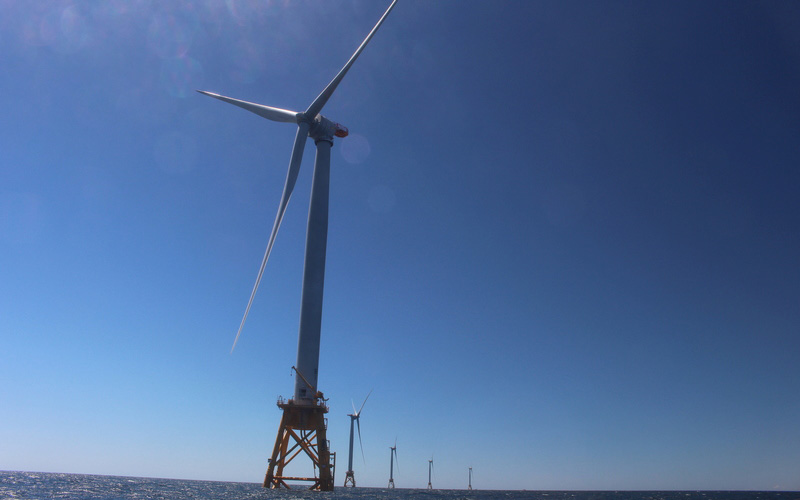
With sea levels and temperatures rising, it is critical that we develop New England’s vast renewable wind energy resources to reduce our use of fossil fuels. With only around 360 North Atlantic right whales left on earth, it is also critical that we safeguard these majestic creatures from harm. With vulnerable right whales swimming through many of the areas where developers could construct wind turbines, can we accomplish both goals?
In a word: Yes! In fact, if we proceed carefully and responsibly, we can develop offshore wind projects in ways that minimize risks and could benefit the marine environment in the long term.
That said, wind turbines could harm right whales if developers don’t plan and build them responsibly. That’s why we’ve developed guidelines for building the offshore wind infrastructure that we desperately need while safeguarding a critically endangered species that can’t afford to lose a single whale.
Here are seven guidelines for how right whales and offshore wind can share the sea:
1. Choose the right location
Scientists have documented specific locations where right whales like to gather for feeding, migrating, and breeding. Developers should exclude these areas from any plans for offshore wind. While it’s impossible to avoid all potential interactions between right whales and offshore wind projects, not building these structures in the whales’ favorite turf is a great start.
2. Choose the right timing
Picking the right time of year and of day for construction is critical for protecting right whales. Offshore wind developers should use the best available data to determine what seasons right whales will most likely frequent an area and avoid harmful construction activities during those times. They should also limit construction to daylight hours when observers can more easily spot whales.
This is vital because construction can produce noise with harmful effects on right whales. Speaking of which …
3. Minimize underwater noise
The construction process for offshore wind turbines can make enough noise to throw off a whale’s ability to navigate and communicate. These noises can drive right whales from their best feeding grounds. This can even lead to right whale mothers losing contact with calves who depend on them for survival.
Luckily, offshore wind developers can use tools and tactics to minimize “noise pollution.” For example, double bubble curtains, in addition to having a very fun name, can block significant amounts of underwater noise. Adopting these and other emerging technologies will minimize construction’s impact on right whales.
4. Monitor for whales
Technologies and techniques for spotting and tracking right whales are also improving, and offshore wind developers should take full advantage of them. Trained human observers can spot nearby whales. Underwater acoustic monitoring devices, if used for 24 hours ahead of time, detect around 75% of right whales in the area. Aerial surveys can also pick up on whales near the surface.
None of these are perfect, but with these tools in use, offshore wind developers can more easily halt construction before it can harm their aquatic neighbors.
5. Set speed limits
Every boat and ship traveling to and from port, and in wind energy project areas, should stick to a speed limit of 10 knots or less. This includes vessels used for offshore wind construction and maintenance. Those low speeds improve the odds that boat captains will be able to spot whales and avoid collisions, which can be catastrophic for both whales and boaters. If a collision does take place, slower speeds equal less damage for both vessels and whales.
A commonsense speed limit keeps everyone safer on the water, just like it does on land.
6. Contribute to long-term research and monitoring
Offshore wind in New England is still in the exciting early stages. That means that we have an enormous opportunity to gather data that will help inform and shape future projects. If developers fund and coordinate with marine experts and make their findings public, we can improve future projects and make the ocean safer for everyone using it.
7. Don’t get derailed by disinformation
Finally, a lesson we could all learn from: Don’t fall for the disinformation! Big Oil and other special interest groups are hard at work spreading false information about how offshore wind is killing whales. But there’s no evidence that offshore wind activities have killed a single whale. Fossil fuel interests are concerned about keeping their oil and their profits flowing, not the fate of North Atlantic right whales.
We know what’s killing right whales: collisions with ships and boats and entanglements in fishing gear. There’s never been a documented case of anything else killing an adult right whale in modern day. Fearmongering about wind turbines is a pointless diversion.
These steps will allow right whales and offshore wind to share the sea as safely as possible. As the first region to fully embrace offshore wind, New England is writing the handbook for how to harness this natural resource responsibly. By taking ocean health into account as we plan, build, and operate offshore wind farms, we can create a gold standard for protecting our precious marine life while successfully ending our dependence on dangerous fossil fuels.



